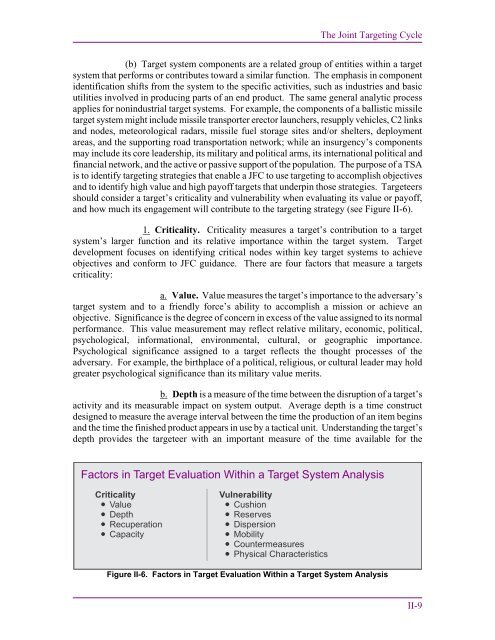Joint Targeting
1F87id9
1F87id9
Create successful ePaper yourself
Turn your PDF publications into a flip-book with our unique Google optimized e-Paper software.
The <strong>Joint</strong> <strong>Targeting</strong> Cycle<br />
(b) Target system components are a related group of entities within a target<br />
system that performs or contributes toward a similar function. The emphasis in component<br />
identification shifts from the system to the specific activities, such as industries and basic<br />
utilities involved in producing parts of an end product. The same general analytic process<br />
applies for nonindustrial target systems. For example, the components of a ballistic missile<br />
target system might include missile transporter erector launchers, resupply vehicles, C2 links<br />
and nodes, meteorological radars, missile fuel storage sites and/or shelters, deployment<br />
areas, and the supporting road transportation network; while an insurgency’s components<br />
may include its core leadership, its military and political arms, its international political and<br />
financial network, and the active or passive support of the population. The purpose of a TSA<br />
is to identify targeting strategies that enable a JFC to use targeting to accomplish objectives<br />
and to identify high value and high payoff targets that underpin those strategies. Targeteers<br />
should consider a target’s criticality and vulnerability when evaluating its value or payoff,<br />
and how much its engagement will contribute to the targeting strategy (see Figure II-6).<br />
1. Criticality. Criticality measures a target’s contribution to a target<br />
system’s larger function and its relative importance within the target system. Target<br />
development focuses on identifying critical nodes within key target systems to achieve<br />
objectives and conform to JFC guidance. There are four factors that measure a targets<br />
criticality:<br />
a. Value. Value measures the target’s importance to the adversary’s<br />
target system and to a friendly force’s ability to accomplish a mission or achieve an<br />
objective. Significance is the degree of concern in excess of the value assigned to its normal<br />
performance. This value measurement may reflect relative military, economic, political,<br />
psychological, informational, environmental, cultural, or geographic importance.<br />
Psychological significance assigned to a target reflects the thought processes of the<br />
adversary. For example, the birthplace of a political, religious, or cultural leader may hold<br />
greater psychological significance than its military value merits.<br />
b. Depth is a measure of the time between the disruption of a target’s<br />
activity and its measurable impact on system output. Average depth is a time construct<br />
designed to measure the average interval between the time the production of an item begins<br />
and the time the finished product appears in use by a tactical unit. Understanding the target’s<br />
depth provides the targeteer with an important measure of the time available for the<br />
Factors in Target Evaluation Within a Target System Analysis<br />
Criticality<br />
• Value<br />
• Depth<br />
• Recuperation<br />
• Capacity<br />
Vulnerability<br />
• Cushion<br />
• Reserves<br />
• Dispersion<br />
• Mobility<br />
• Countermeasures<br />
• Physical Characteristics<br />
Figure II-6. Factors in Target Evaluation Within a Target System Analysis<br />
II-9


